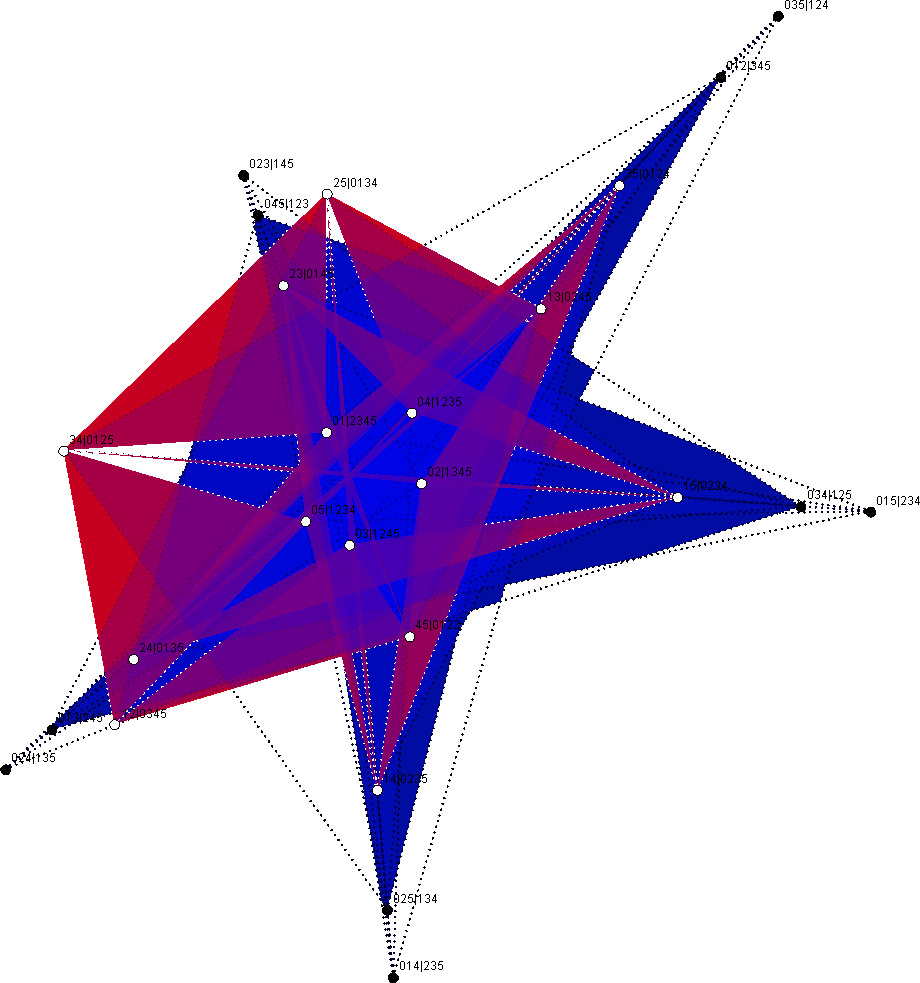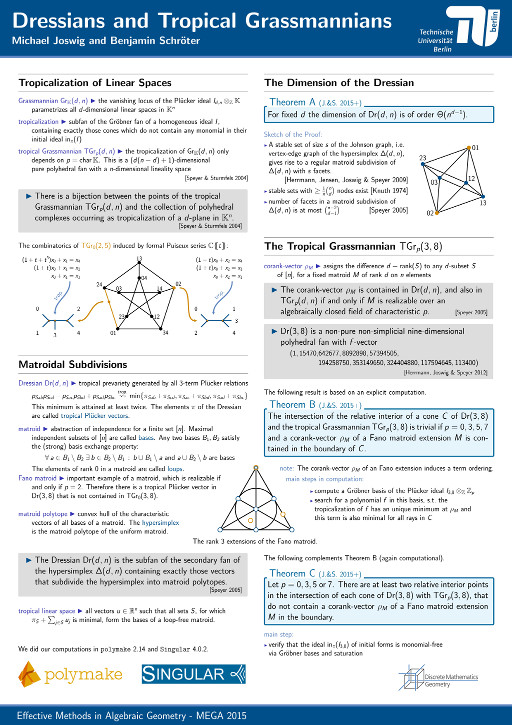Publications (pdf)
- Valuative invariants for large classes of matroids with Luis Ferroni
in Journal of the London Mathematical Society, Volume 110(3) (2024), e12984
Valuative invariants for large classes of matroids
We study an operation in matroid theory that allows to transition a given matroid into another with more bases via relaxing a “stressed subset”. This provides a framework in which we obtain a new combinatorial characterization of the class of elementary split matroids, which is expected to be asymptotically predominant. Moreover, it enables to describe an explicit matroid subdivision of a hypersimplex, which in turn can be used to write down explicit formulas for the evaluations of any valuative invariant on these matroids. This shows that evaluations depend solely on the behavior of the invariant on a well-behaved small subclass of Schubert matroids that we call “cuspidal matroids”. Along the way, we make a comprehensive summary of the tools and methods one might use to prove that an invariant is valuative, and we use them to provide new proofs of the valuativeness of several invariants. We address systematically the consequences of our approach for a comprehensive list of invariants. They include the volume and Ehrhart polynomial of base polytopes, the Tutte polynomial, Kazhdan–Lusztig polynomials, the Whitney numbers of the first and second kind, spectrum polynomials and a generalization of these by Denham, chain polynomials and Speyer’s g-polynomials, as well as Chow rings of matroids and their Hilbert–Poincaré series. The flexibility of this setting allows us to give a unified explanation for several recent results regarding the listed invariants; furthermore, we emphasize it as a powerful computational tool to produce explicit data and concrete examples.
|
- Massively parallel computation of tropical varieties, their positive part, and tropical Grassmannians with D. Bendle, J. Böhm and Y. Ren
in Journal of Symbolic Computation. Special Issue: MEGA 2022 120 (2024), 102224
Massively parallel computation of tropical varieties, their positive part, and tropical Grassmannians
We present a massively parallel framework for computing tropicalizations of algebraic varieties which can make use of symmetries using the workflow management system GPI-Space and the computer algebra system Singular. We determine the tropical Grassmannian TGr0(3,8). Our implementation works efficiently on up to 840 cores, computing the 14763 orbits of maximal cones under the canonical S8-action in about 20 minutes.
Relying on our result, we show that the Gröbner structure of TGr0(3,8) refines the 16-dimensional skeleton of the coarsest fan structure of the Dressian Dr(3,8), except for 23 orbits of special cones, for which we construct explicit obstructions to the realizability of their tropical linear spaces. Moreover, we propose algorithms for identifying maximal-dimensional cones which belong to positive tropicalizations of algebraic varieties. We compute the positive Grassmannian TGr+(3,8) and compare it to the cluster complex of the classical Grassmannian Gr(3,8).
|
- The Merino-Welsh Conjecture for split matroids with Luis Ferroni
in Annals of Combinatorics 27(3) (2023), 737–748
The Merino-Welsh Conjecture for split matroids
In 1999 Merino and Welsh conjectured that evaluations of the Tutte polynomial of a graph satisfy an inequality. In this short article we show that the conjecture generalized to matroids holds for the large class of all split matroids by exploiting the structure of their lattice of cyclic flats. This class of matroids strictly contains all paving and copaving matroids.
|
- Parametric shortest-path algorithms via tropical geometry with Michael Joswig
in Mathematics of Operations Research 47(3) (2022), 2065–2081
Parametric shortest-path algorithms via tropical geometry
We study parameterized versions of classical algorithms for computing shortest-path trees. This is most easily expressed in terms of tropical geometry. Applications include shortest paths in traffic networks with variable link travel times.
|
- Ehrhart polynomials of rank two matroids with Luis Ferroni and Katharina Jochemko
in Advances in Applied Mathematics 141 (2022), 102410, 26 pages
Ehrhart polynomials of rank two matroids
Over a decade ago De Loera, Haws and Köppe conjectured that Ehrhart polynomials of matroid polytopes have only positive coefficients. This intensively studied conjecture has recently been disproved by the first author who gave counterexamples of all ranks greater or equal to three. In this article we complete the picture by showing that Ehrhart polynomials of matroids of lower rank have indeed only positive coefficients. Moreover, we show that they are coefficient-wise bounded by the minimal and the uniform matroid.
|
- Correlation bounds for fields and matroids with June Huh and Botong Wang
in Journal of the European Mathematical Society 24 (2022), 1335–1351
Correlation bounds for fields and matroids
Let G be a finite connected graph, and let T be a spanning tree of G chosen uniformly at random. The work of Kirchhoff on electrical networks can be used to show that the events e1∈T and e2∈T are negatively correlated for any distinct edges e1 and e2. What can be said for such events when the underlying matroid is not necessarily graphic? We use Hodge theory for matroids to bound the correlation between the events e∈B, where B is a randomly chosen basis of a matroid. As an application, we prove Mason's conjecture that the number of k-element independent sets of a matroid forms an ultra-log-concave sequence in k.
|
- Reconstructibility of matroid polytopes with Guillermo Pineda-Villavicencio
in SIAM Journal on Discrete Mathematics 36 (2022), 490–508
Reconstructibility of matroid polytopes
We specify what is meant when a polytope is reconstructible from its graph or dual graph, and introduce the problem of class reconstructibility, i.e., the (dual) graph of a polytope is unique within a given class of polytopes. We provide examples showing that cubical polytopes and matroid (base) polytopes are not reconstructible from either their graphs or their dual graphs. In fact, our counterexamples for matroid polytopes include hypersimplices. Furthermore, we prove that matroid polytopes are class reconstructible form their graphs, and we present a O(n3) algorithm that computes the vertices of a matroid polytope from its n-vertex graph. Additionally, our proof includes a characterisation of all matroids with isomorphic basis exchange graphs.
|
- Moduli spaces of codimension-one subspaces in a linear variety and their tropicalization with Philipp Jell, Hannah Markwig and Felipe Rincón
in Electronic Journal of Combinatorics 29(2) (2022), P2.31, 33 pages
Moduli spaces of codimension-one subspaces in a linear variety and their tropicalization
We study the moduli space of d-dimensional linear subspaces contained in a fixed (d+1)-dimensional linear variety X, and its tropicalization. We prove that these moduli spaces are linear subspaces themselves, and thus their tropicalization is completely determined by their associated (valuated) matroids. We show that these matroids can be interpreted as the matroid of lines of the hyperplane arrangement corresponding to X, and generically are equal to a Dilworth truncation of the free matroid. In this way, we can describe combinatorially tropicalized Fano schemes and tropicalizations of moduli spaces of stable maps of degree 1 to a plane.
|
- On local Dressians of matroids with Jorge Alberto Olarte and Marta Panizzut
in Algebraic and Geometric Combinatorics on Lattice Polytopes. Proceedings of the Summer Workshop on Lattice Polytopes, Osaka 2018 (2019), 309–329
On local Dressians of matroids
We study the fan structure of Dressians Dr(d,n) and local Dressians Dr(M) for a given matroid M. In particular we show that the fan structure on Dr(M) given by the three term Plücker relations coincides with the structure as a subfan of the secondary fan of the matroid polytope P(M). As a corollary, we have that a matroid subdivision is determined by its 3-dimensional skeleton. We also prove that the Dressian of the sum of two matroids is isomorphic to the product of the Dressians of the matroids. Finally we focus on indecomposable matroids. We show that binary matroids are indecomposable, and we provide a non-binary indecomposable matroid as a counterexample for the converse.
|
- Multi-splits and tropical linear spaces from nested matroids
in Discrete & Computational Geometry 61.3 (2019), 661–685
Multi-splits and tropical linear spaces from nested matroids
In this paper we present an explicit combinatorial description of a special class of facets of the secondary polytopes of hypersimplices. These facets correspond to polytopal subdivisions called multi-splits. We show a relation between the cells in a multi-split of the hypersimplex and nested matroids. Moreover, we get a description of all multi-splits of a product of simplices. Additionally, we present a computational result to derive explicit lower bounds on the number of facets of secondary polytopes of hypersimplices.
|
- Algorithms for tight spans and tropical linear spaces with Simon Hampe and Michael Joswig
in Journal of Symbolic Computation. Special Issue: MEGA 2017 91 (2019), 116–128
Algorithms for Tight Spans and Tropical Linear Spaces
We describe a new method for computing tropical linear spaces and more general duals of polyhedral subdivisions. It is based on Ganter's algorithm (1984) for finite closure systems.
|
- The degree of a tropical basis with Michael Joswig
in Proceedings of the American Mathematical Society 146 (2018), 961–970
The degree of a tropical basis
We give an explicit upper bound for the degree of a tropical basis of a homogeneous polynomial ideal. As an application f-vectors of tropical varieties are discussed. Various examples illustrate differences between Gröbner and tropical bases.
|
- Matroids from hypersimplex splits with Michael Joswig
in Journal of Combinatorial Theory Series A 151 (2017), 254–284
Matroids from hypersimplex splits
A class of matroids is introduced which is very large as it strictly contains all paving matroids as special cases. As their key feature these split matroids can be studied via techniques from polyhedral geometry. It turns out that the structural properties of the split matroids can be exploited to obtain new results in tropical geometry, especially on the rays of the tropical Grassmannians.
|
- Linear programs and convex hulls over fields of Puiseux fractions with Michael Joswig, Georg Loho and Benjamin Lorenz
in Lecture Notes in Computer Science, Mathematical Aspects of Computer and Information Sciences. MACIS 2015 – 6th International Conference (2016), 429–445
Linear Programs and Convex Hulls Over Fields of Puiseux Fractions
We describe the implementation of a subfield of the field of formal Puiseux series in polymake. This is employed for solving linear programs and computing convex hulls depending on a real parameter. Moreover, this approach is also useful for computations in tropical geometry.
|

